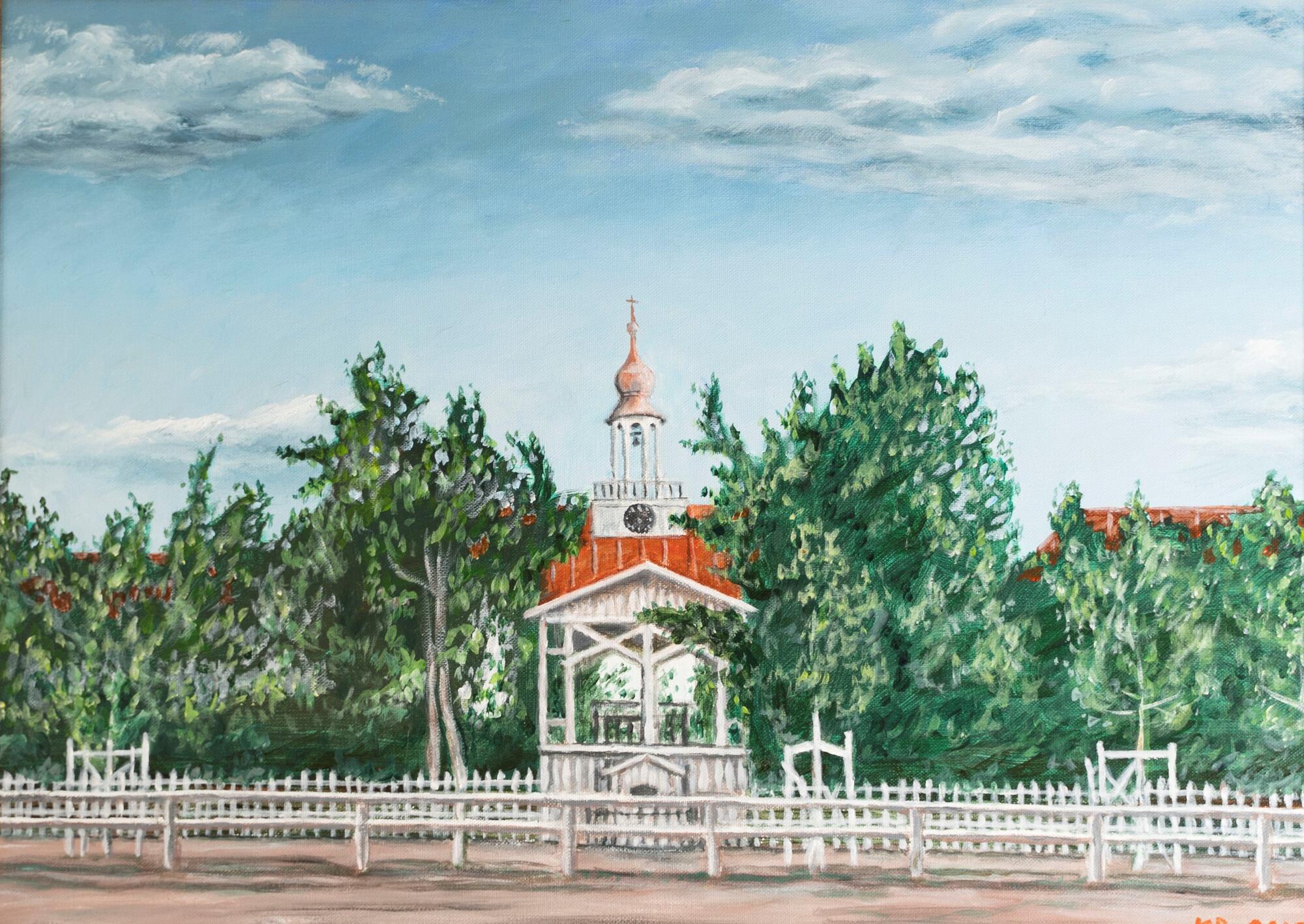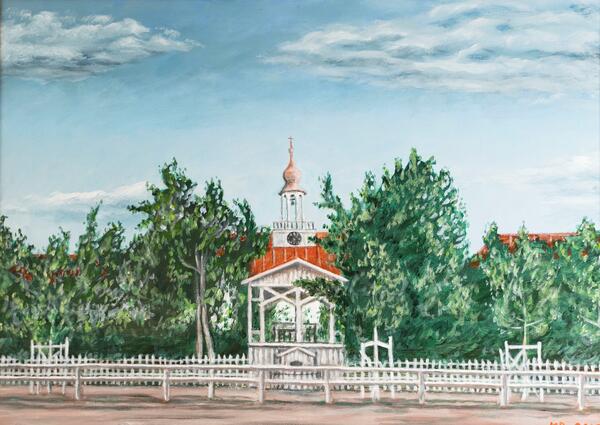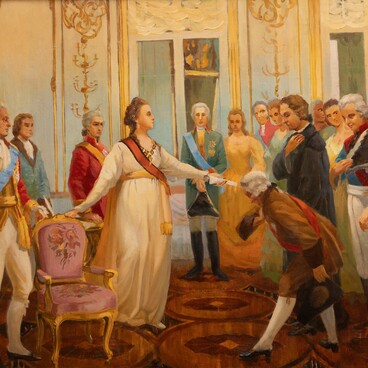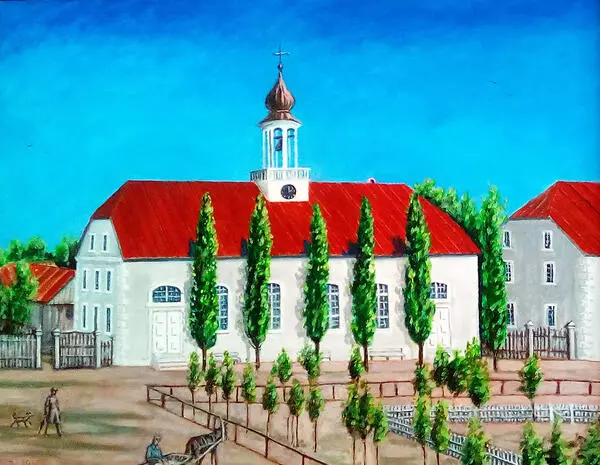There were many reservoirs, basins, standpipes with fresh running water in the German colony of Sarepta. The town was surrounded by lush gardens and vineyards. Thanks to this, Sarepta was called a ‘green oasis’ in the hot Astrakhan steppe.
There was a basin and a reservoir with a pavilion enclosed by a low wooden fence in the center of the settlement Church Square. The accumulating fountain was an important component of the Sarepta water supply system hat is the very fountain that the Volgograd-born artist Valery Konkov portrayed in his painting.
In 1765, the Germans, who arrived in these places to found a colony, discovered two springs on the ErgenI Upland not far from Sarepta. The colonists refused to use water from the Volga and Sarpa rivers, therefore, only spring water was used for drinking and for household needs.
In 1767, a wooden gravity water supply was installed from the Schönbrunn spring to Sarepta, which delivered water to the colony at a rate of one thousand buckets per hour. It was the first European water supply system in the Lower Volga region and the first public utility of the community.
Water flowed through pipes by gravity into the purification basin, where it was settled and filtered through a thin copper mesh. In the center of the square was an underground reservoir equipped with a pump to supply water to fire hydrants in the colony. Pipes were laid from the reservoir to street wells and standpipes, households, industrial enterprises and handicraft workshops, to the gardens and plantations of the Sareptians, as well as for irrigation of green spaces and forest belts.
In 1803, all wooden pipes were replaced with local ceramic pipes. Rules for using the communal water supply system were drawn up for the inhabitants of the surrounding villages, and were placed at the water taps. The text on the plaque read: ‘Do not wash the buckets! Do not scoop with your hands! It is prohibited to export water to all residents of the surrounding villages! “. The water pipeline saved the colonists from cholera in the first Russian epidemic in 1830, and from all other epidemics that happened later.
The colony had own plumber. The water supply was financed by the Community Committee, a municipal self-government body. It charged owners and users and determined the cost of repairs.
At the beginning of the 20th century, a water supply system made of cast iron and galvanized pipes, which replaced ceramic and wooden ones, supplied the population of the colony of 3400 with drinking water. Its maintenance costs were 1200 rubles. The number of public fountains increased to 10, water was supplied to 21 private houses.
There was a basin and a reservoir with a pavilion enclosed by a low wooden fence in the center of the settlement Church Square. The accumulating fountain was an important component of the Sarepta water supply system hat is the very fountain that the Volgograd-born artist Valery Konkov portrayed in his painting.
In 1765, the Germans, who arrived in these places to found a colony, discovered two springs on the ErgenI Upland not far from Sarepta. The colonists refused to use water from the Volga and Sarpa rivers, therefore, only spring water was used for drinking and for household needs.
In 1767, a wooden gravity water supply was installed from the Schönbrunn spring to Sarepta, which delivered water to the colony at a rate of one thousand buckets per hour. It was the first European water supply system in the Lower Volga region and the first public utility of the community.
Water flowed through pipes by gravity into the purification basin, where it was settled and filtered through a thin copper mesh. In the center of the square was an underground reservoir equipped with a pump to supply water to fire hydrants in the colony. Pipes were laid from the reservoir to street wells and standpipes, households, industrial enterprises and handicraft workshops, to the gardens and plantations of the Sareptians, as well as for irrigation of green spaces and forest belts.
In 1803, all wooden pipes were replaced with local ceramic pipes. Rules for using the communal water supply system were drawn up for the inhabitants of the surrounding villages, and were placed at the water taps. The text on the plaque read: ‘Do not wash the buckets! Do not scoop with your hands! It is prohibited to export water to all residents of the surrounding villages! “. The water pipeline saved the colonists from cholera in the first Russian epidemic in 1830, and from all other epidemics that happened later.
The colony had own plumber. The water supply was financed by the Community Committee, a municipal self-government body. It charged owners and users and determined the cost of repairs.
At the beginning of the 20th century, a water supply system made of cast iron and galvanized pipes, which replaced ceramic and wooden ones, supplied the population of the colony of 3400 with drinking water. Its maintenance costs were 1200 rubles. The number of public fountains increased to 10, water was supplied to 21 private houses.




